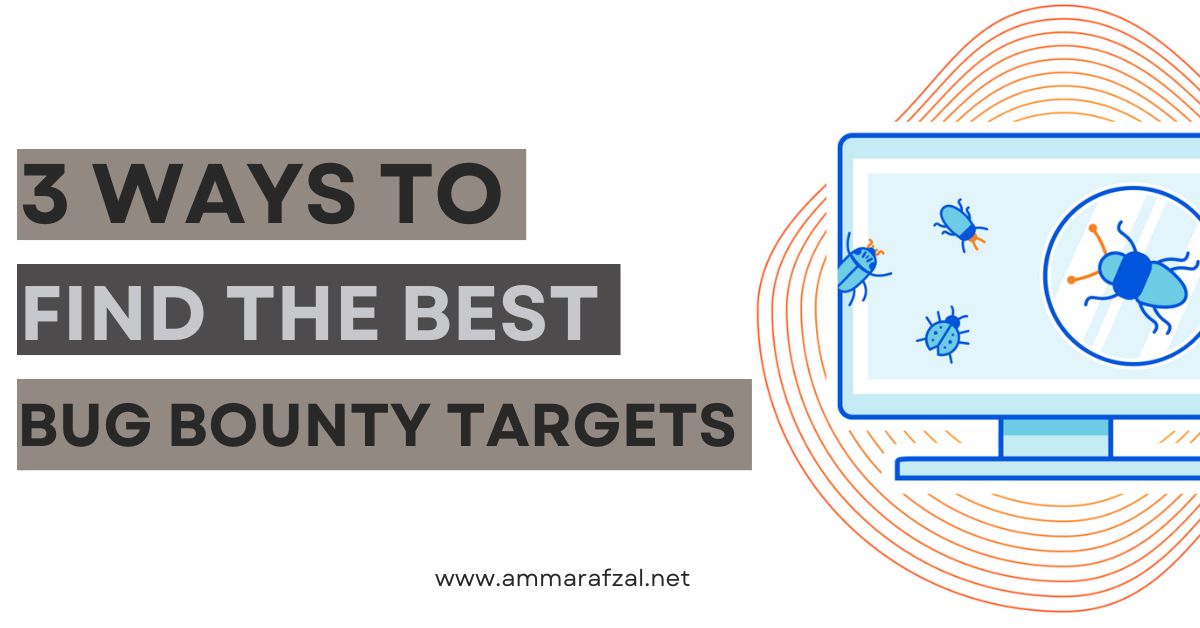Bug Bounty Targets hunting is an exciting field where security researchers find vulnerabilities in applications and get rewarded. However, one of the biggest challenges is finding the right target. With thousands of programs available, choosing the best ones can significantly impact your success rate. Some targets have higher payouts, while others have fewer researchers testing them, increasing your chances of finding unique vulnerabilities. But how do you choose the perfect one?
This guide will walk you through five essential steps to find the best Bug Bounty Targets. From selecting the right platform to using Google Dorks, expanding the attack surface, and ensuring compliance, this article will equip you with expert techniques to enhance your bug hunting skills. This blog is part of a comprehensive bug bounty series, guiding you from beginner to advanced hacking techniques from finding targets to successfully exploiting vulnerabilities.
Who Am I?
My name is Ammar Afzal, and I am a software developer specializing in mobile and web development. I am also a cybersecurity researcher who is continuously learning and improving my skills. I have completed specialized training in mobile application penetration testing, web penetration testing, and bug bounty training from TCM Security. My expertise allows me to identify security vulnerabilities and help organizations secure their applications. Being from Pakistan, I am passionate about ethical hacking and penetration testing, ensuring that digital platforms remain protected from cyber threats.
In addition to my development skills, I possess a strong background in cybersecurity, particularly in penetration testing and vulnerability assessment. I have hands-on experience with web application security, API security, and mobile security testing. My expertise in tools like Burp Suite, Nmap, Metasploit, and OWASP ZAP enables me to conduct thorough security assessments. I continuously research zero-day vulnerabilities, participate in CTF competitions, and stay updated on the latest cybersecurity threats and mitigation techniques.
My proactive approach ensures that the digital solutions I develop are not only functional and user-friendly but also secure against potential vulnerabilities. Through Bug Bounty Targets hunting, I contribute to making the internet a safer place by helping companies identify and fix security flaws before they are exploited by malicious hackers.
Stay Connected
To stay updated with my latest research, insights, and bug bounty findings, connect with me on social media:
- LinkedIn: shammarafzal
- Twitter: shammarafzal
- Instagram: shammarafzal
1. Choose a Suitable Bug Bounty Platform
The first step in finding bug bounty targets is selecting the right platform. Several platforms host bug bounty programs, each offering different scopes, rules, and reward structures. Choosing the right one based on your expertise can maximize your success.
Popular Bug Bounty Targets Finding Platforms
- HackerOne – Hosts many high-paying and private programs.
- Bugcrowd – Offers public, private, and crowdsourced security testing programs.
- Intigriti – A rising platform with lucrative bounty rewards.
- Open Bug Bounty – Ideal for testing public websites without registration.
- Company-Specific Bug Bounty Pages – Some companies, like Google, Facebook, and Apple, have their own bug bounty programs listed on their security pages.
What to Look for in a Target?
✅ Full-Scope Programs: Look for programs that include wildcard domains, IP ranges, mobile apps, and APIs. This increases your attack surface.
✅ Less Competition: Choose programs with fewer resolved reports, increasing your chances of discovering new vulnerabilities.
✅ High Payouts: Some companies offer bigger rewards for critical vulnerabilities, making them more profitable.
✅ Average Time to First Response: Check how quickly the bug bounty team responds to submissions. A long response time can mean delays in validation and payouts, making the effort less worthwhile.
Understanding Private vs. Public Programs
Bug bounty platforms offer two types of programs:
- Public Programs: Open to all researchers. They have high competition but also offer transparency in past reports.
- Private Programs: Invitation-only. These often have higher payouts and lower competition, making them valuable for experienced hunters.
2. Use Google Dorks to Find Targets
Google Dorks help bug bounty hunters find exposed endpoints, admin panels, sensitive files, and API keys that companies may have unintentionally left accessible.
Finding Admin Panels and Login Portals
- site:example.com inurl:admin → Locate admin login pages.
- site:example.com intitle:”login” → Find login portals using their page titles.
- site:example.com inurl:signin OR inurl:auth → Search for authentication pages.

Finding Exposed Sensitive Documents
- site:example.com filetype:pdf OR filetype:doc → Find publicly exposed documents.
- site:example.com filetype:log → Search for exposed log files that may contain credentials.
- site:example.com inurl:/config filetype:xml → Look for configuration files with sensitive data.
Finding Open Directories
- site:example.com intitle:”index of” “parent directory” → Identify open directories.
- site:example.com intitle:”index of” /backup → Search for backup directories.
3. Identify Horizontal and Vertical Domains
Expanding the attack surface is essential in bug bounty hunting. Instead of testing a single domain, look for related assets that may also be vulnerable.
Horizontal Domain Discovery
- Identify subdomains using tools like Subfinder, Amass, or Asset Finder.
- Look for related services, acquisitions, and third-party platforms.
- Example: If the main target is example.com, other assets like dev.example.com or api.example.com may be in scope.
Vertical Domain Expansion
- Search for IP ranges using ASN lookup tools.
- Find cloud services and external hosting platforms used by the company.
- Example: If a company uses AWS, check s3.amazonaws.com/example-bucket for misconfigurations.
Conclusion
Finding the right Bug Bounty Targets is a crucial step in a successful hunt. By carefully selecting the right platform, such as HackerOne, Bugcrowd, or Integriti, you’re positioning yourself for a successful engagement. Utilizing Google Dorks is a great way to expand your search beyond the obvious targets, uncovering hidden vulnerabilities that others might miss. Once you’ve identified your target, don’t just focus on the primary domain expand to horizontal and vertical domains to uncover potential attack vectors across a broader surface area.
Always make sure to verify the scope before diving in to ensure you’re not stepping outside the boundaries of what’s authorized. Prioritizing high-value targets, like those with a full scope or wildcard domains, allows you to maximize your chances of discovering critical vulnerabilities and earning significant rewards. With the right approach, you can take your bug bounty journey to the next level.
🚀 Start your bug bounty journey today! The opportunities are limitless, and with careful strategy and persistence, you can turn your skills into valuable rewards! 🚀

